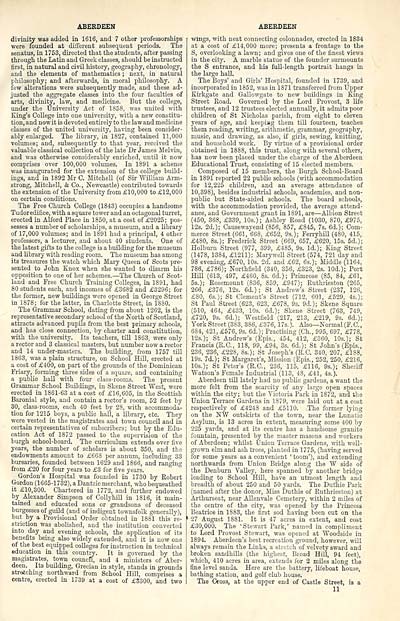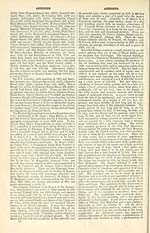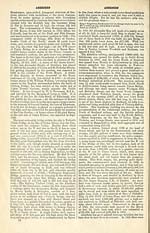Ordnance gazetteer of Scotland
(19) Page 11 - ABE
Download files
Complete book:
Individual page:
Thumbnail gallery: Grid view | List view

ABERDEEN
divinity was added in 1616, and 7 other professorships
were founded at different subsequent periods. The
senatus, in 1753, directed that the students, after passing
through the Latin and Greek classes, should be instructed
first, in natural and civil history, geography, chronology,
and the elements of mathematics ; next, in natural
philosophy; and afterwards, in moral philosophy. A
few alterations were subsequently made, and these ad-
justed the aggregate classes into the four faculties of
arts, divinity, law, and medicine. But the college,
under the University Act of 1858, was united with
King's College into one university, with a new constitu-
tion, and nowit is devoted entirely to the lawand medicine
classes of the united university, having been consider-
ably enlarged. The library, in 1827, contained 11,000
volumes; and, subsequently to that year, received the
valuable classical collection of the late Dr James Melvin,
and was otherwise considerably enriched, until it now
comprises over 100,000 volumes. In 1891 a scheme
was inaugurated for the extension of the college build-
ings, and in 1892 Mr C. Mitchell (of Sir William Arm-
strong, Mitchell, & Co., Newcastle) contributed towards
the extension of the University from £10,000 to £12,000
on certain conditions.
The Free Church College (1843) occupies a handsome
Tudoredifice, with a square tower and an octagonal turret,
erected in Alford Place in 1850, at a cost of £2025; pos-
sesses a number of scholarships, a museum, and a library
of 17,000 volumes; and in 1891 had a principal, 4 other
professors, a lecturer, and about 40 students. One of
the latest gifts to the college is a building for the museum
and library with reading room. The museum has among
its treasures the watch which Mary Queen of Scots pre-
sented to John Enox when she wanted to disarm his
opposition to one of her schemes. — The Church of Scot-
land and Free Church Training Colleges, in 1891, had
80 students each, and incomes of £3682 and £3296; for
the former, new buildings were opened in George Street
in 1878; for the latter, in Charlotte Street, in 1880.
The Grammar School, dating from about 1262, is the
representative secondary school of the North of Scotland,
attracts advanced pupils from the best primary schools,
and has close connection, by charter and constitution,
with the university. Its teachers, till 1863, were only
a rector and 3 classical masters, but number now a rector
and 14 under-masters. The building, from 1757 till
1863, was a plain structure, on School Hill, erected at
a cost of £400, on part of the grounds of the Dominican
Friary, forming three sides of a square, and containing
a public hall with four class-rooms. The present
Gram mar School Buildings, in Skene Street West, were
erected in 1861-63 at a cost of £16,605, in the Scottish
Baronial style, and contain a rector's room, 52 feet by
30, class-rooms, each 40 feet by 28, with accommoda-
tion for 1215 boys, a public hall, a library, etc. They
were vested in the magistrates and town council and in
certain representatives of subscribers; but by the Edu-
cation Act of 1872 passed to the supervision of the
burgh school-board. The curriculum extends over five
years, the number of scholars is about 350, and the
endowments amount to £668 per annum, including 33
bursaries, founded between 1629 and 1866, and ranging
from £20 for four years to £3 for five years.
Gordon's Hospital was founded in 1730 by Robert
Gordon (1665-1732), a Dantzic merchant, who bequeathed
it £10,300. Chartered in 1772, and further endowed
by Alexander Simpson of Collyhill in 1816, it main-
tained and educated sons or grandsons of deceased
burgesses of guild (and of indigent townsfolk generally),
but by a Provisional Order obtained in 1881 this re-
striction was abolished, and the institution converted
into day and evening schools, the application of its
benefits being also widely extended, and it is now one
of the best equipped colleges for instruction in technical
education in this country. It is governed by the
magistrates, town council, and 4 ministers of Aber-
deen. Its building, Grecian in style, stands in grounds
stretching northward from School Hill, comprises a
centre, erected in 1739 at a cost of £3300, and two
ABERDEEN
wings, with neat connecting colonnades, erected in 1834
at a cost of £14,000 more; presents a frontage to the
S, overlooking a lawn; and gives one of the finest views
in the city. A marble statue of the founder surmounts
the S entrance, and his full-length portrait hangs in
the large hall.
The Boys' and Gfrls' Hospital, founded in 1739, and
incorporated in 1852, was in 1871 transferred from Upper
Kirkgate and Gallowgate to new buildings in King
Street Road. Governed by the Lord Provost, 3 life
trustees, and 12 trustees elected annually, it admits poor
children of St Nicholas parish, from eight to eleven
years of age, and keeping them till fourteen, teaches
them reading, writing, arithmetic, grammar, geography,
music, and drawing, as also, if girls, sewing, knitting,
and household work. By virtue of a provisional order
obtained in 1888, this trust, along with several others,
has now been placed under the charge of the Aberdeen
Educational Trust, consisting of 15 elected members.
Composed of 15 members, the Burgh School-Board
in 1891 reported 22 public schools (with accommodation
for 12,225 children, and an average attendance of
10,398), besides industrial schools, academies, and non-
public but State-aided schools. The board schools,
with the accommodation provided, the average attend-
ance, and Government grant in 1891, are — Albion Street
(450, 368, £339, 10s.); Ashley Road (1030, 870, £975,
12s. 2d.); Causewayend (856, 857, £845, 7s. 6d.); Com-
merce Street (661, 668, £652, 9s.); Ferryhill (480, 415,
£480, 8s.); Frederick Street (669, 657, £620, 15s. 5d.);
Holburn Street (977, 399, £485, 9s. Id.);. Eing Street
(1478, 1384, £1211); Marywell Street (574, 721 day and
98 evening, £670, 10s. 2d. and £62, 6s.); Middle (1164,
786, £786); Northfield (340, 356, £323, 2s. 10d.); Port
Hill (613, 497, £460, 8s. 6d.); Primrose (85, 84, £61,
5s.); Rosemount (836, 859, £947); Ruthrieston (265,
266, £376, 12s. 6d.); St Andrew's Street (237, 126,
£80, 6s.); St Clement's Street (712, 601, £529, 4s.);
St Paul Street (623, 623, £678, 9s. 9d.); Skene Square
(510, 464, £433, 10s. 6d.); Skene Street (763, 749,
£720, 9s. 6d.); Westfield (217, 213, £219, 9s. 6d.);
YorkStreet (383, 386, £376, 17s.). Also— Normal (F. C. ,
684, 421, £576, 9s. 6d.); Practising (Ch., 995, 697, £778,
12s.); St Andrew's (Epis., 454, 412, £360, 10s.); St
Francis (R.C., 118, 99, £94, 3s. 6d.); St John's (Epis.,
236, 236, £228, 8s.); St Joseph's (R.C. 340, 207, £188,
19s. 7d.); St Margaret's, Mission (Epis., 252, 250, £216,
10s.); St Peter's (R.C, 236, 115, £116, 9s.); Sheriff
Watson's Female Industrial (113, 48, £41, 4s.).
Aberdeen till lately had no public gardens, a want the
more felt from the scarcity of any large open spaces
within the city; but the Victoria Park in 1872, and the
Union Terrace Gardens in 1879, were laid out at a cost
respectively of £4248 and £5110. The former lying
on the NW outskirts of the town, near the Lunatic
Asylum, is 13 acres in extent, measuring some 400 by
225 yards, and at its centre has a handsome granite
fountain, presented by the master masons and workers
of Aberdeen; whilst Union Terrace Gardens, with well-
grown elm and ash trees, planted in 1775, (having served
for some years as a convenient ' toom'), and extending
northwards from Union Bridge along the W side of
the Denburn Valley, here spanned by another bridge
leading to School Hill, have an utmost length and
breadth of about 250 and 50 yards. The Dutliie Park
(named after the donor, Miss Duthie of Ruthrieston) at
Arthurseat, near Allenvale Cemetery, within 2 miles of
the centre of the city, was opened by the Princess
Beatrice in 1883, the first sod having been cut on the
1 27 August 1881. It is 47 acres in extent, and cost
£30,000. The 'Stewart Park,' named in compliment
to Lord Provost Stewart, was opened at Woodside in
1894. Aberdeen's best recreation ground, however, will
always remain the Links, a stretch of velvety sward and
broken sandhills (the highest, Broad HilL 94 feet),
which, 410 acres in area, extends for 2 miles along the
fine level sands. Here are the battery, lifeboat house,
bathing station, and golf club house.
The Cross, at the upper end of Castle Street, is a
11
divinity was added in 1616, and 7 other professorships
were founded at different subsequent periods. The
senatus, in 1753, directed that the students, after passing
through the Latin and Greek classes, should be instructed
first, in natural and civil history, geography, chronology,
and the elements of mathematics ; next, in natural
philosophy; and afterwards, in moral philosophy. A
few alterations were subsequently made, and these ad-
justed the aggregate classes into the four faculties of
arts, divinity, law, and medicine. But the college,
under the University Act of 1858, was united with
King's College into one university, with a new constitu-
tion, and nowit is devoted entirely to the lawand medicine
classes of the united university, having been consider-
ably enlarged. The library, in 1827, contained 11,000
volumes; and, subsequently to that year, received the
valuable classical collection of the late Dr James Melvin,
and was otherwise considerably enriched, until it now
comprises over 100,000 volumes. In 1891 a scheme
was inaugurated for the extension of the college build-
ings, and in 1892 Mr C. Mitchell (of Sir William Arm-
strong, Mitchell, & Co., Newcastle) contributed towards
the extension of the University from £10,000 to £12,000
on certain conditions.
The Free Church College (1843) occupies a handsome
Tudoredifice, with a square tower and an octagonal turret,
erected in Alford Place in 1850, at a cost of £2025; pos-
sesses a number of scholarships, a museum, and a library
of 17,000 volumes; and in 1891 had a principal, 4 other
professors, a lecturer, and about 40 students. One of
the latest gifts to the college is a building for the museum
and library with reading room. The museum has among
its treasures the watch which Mary Queen of Scots pre-
sented to John Enox when she wanted to disarm his
opposition to one of her schemes. — The Church of Scot-
land and Free Church Training Colleges, in 1891, had
80 students each, and incomes of £3682 and £3296; for
the former, new buildings were opened in George Street
in 1878; for the latter, in Charlotte Street, in 1880.
The Grammar School, dating from about 1262, is the
representative secondary school of the North of Scotland,
attracts advanced pupils from the best primary schools,
and has close connection, by charter and constitution,
with the university. Its teachers, till 1863, were only
a rector and 3 classical masters, but number now a rector
and 14 under-masters. The building, from 1757 till
1863, was a plain structure, on School Hill, erected at
a cost of £400, on part of the grounds of the Dominican
Friary, forming three sides of a square, and containing
a public hall with four class-rooms. The present
Gram mar School Buildings, in Skene Street West, were
erected in 1861-63 at a cost of £16,605, in the Scottish
Baronial style, and contain a rector's room, 52 feet by
30, class-rooms, each 40 feet by 28, with accommoda-
tion for 1215 boys, a public hall, a library, etc. They
were vested in the magistrates and town council and in
certain representatives of subscribers; but by the Edu-
cation Act of 1872 passed to the supervision of the
burgh school-board. The curriculum extends over five
years, the number of scholars is about 350, and the
endowments amount to £668 per annum, including 33
bursaries, founded between 1629 and 1866, and ranging
from £20 for four years to £3 for five years.
Gordon's Hospital was founded in 1730 by Robert
Gordon (1665-1732), a Dantzic merchant, who bequeathed
it £10,300. Chartered in 1772, and further endowed
by Alexander Simpson of Collyhill in 1816, it main-
tained and educated sons or grandsons of deceased
burgesses of guild (and of indigent townsfolk generally),
but by a Provisional Order obtained in 1881 this re-
striction was abolished, and the institution converted
into day and evening schools, the application of its
benefits being also widely extended, and it is now one
of the best equipped colleges for instruction in technical
education in this country. It is governed by the
magistrates, town council, and 4 ministers of Aber-
deen. Its building, Grecian in style, stands in grounds
stretching northward from School Hill, comprises a
centre, erected in 1739 at a cost of £3300, and two
ABERDEEN
wings, with neat connecting colonnades, erected in 1834
at a cost of £14,000 more; presents a frontage to the
S, overlooking a lawn; and gives one of the finest views
in the city. A marble statue of the founder surmounts
the S entrance, and his full-length portrait hangs in
the large hall.
The Boys' and Gfrls' Hospital, founded in 1739, and
incorporated in 1852, was in 1871 transferred from Upper
Kirkgate and Gallowgate to new buildings in King
Street Road. Governed by the Lord Provost, 3 life
trustees, and 12 trustees elected annually, it admits poor
children of St Nicholas parish, from eight to eleven
years of age, and keeping them till fourteen, teaches
them reading, writing, arithmetic, grammar, geography,
music, and drawing, as also, if girls, sewing, knitting,
and household work. By virtue of a provisional order
obtained in 1888, this trust, along with several others,
has now been placed under the charge of the Aberdeen
Educational Trust, consisting of 15 elected members.
Composed of 15 members, the Burgh School-Board
in 1891 reported 22 public schools (with accommodation
for 12,225 children, and an average attendance of
10,398), besides industrial schools, academies, and non-
public but State-aided schools. The board schools,
with the accommodation provided, the average attend-
ance, and Government grant in 1891, are — Albion Street
(450, 368, £339, 10s.); Ashley Road (1030, 870, £975,
12s. 2d.); Causewayend (856, 857, £845, 7s. 6d.); Com-
merce Street (661, 668, £652, 9s.); Ferryhill (480, 415,
£480, 8s.); Frederick Street (669, 657, £620, 15s. 5d.);
Holburn Street (977, 399, £485, 9s. Id.);. Eing Street
(1478, 1384, £1211); Marywell Street (574, 721 day and
98 evening, £670, 10s. 2d. and £62, 6s.); Middle (1164,
786, £786); Northfield (340, 356, £323, 2s. 10d.); Port
Hill (613, 497, £460, 8s. 6d.); Primrose (85, 84, £61,
5s.); Rosemount (836, 859, £947); Ruthrieston (265,
266, £376, 12s. 6d.); St Andrew's Street (237, 126,
£80, 6s.); St Clement's Street (712, 601, £529, 4s.);
St Paul Street (623, 623, £678, 9s. 9d.); Skene Square
(510, 464, £433, 10s. 6d.); Skene Street (763, 749,
£720, 9s. 6d.); Westfield (217, 213, £219, 9s. 6d.);
YorkStreet (383, 386, £376, 17s.). Also— Normal (F. C. ,
684, 421, £576, 9s. 6d.); Practising (Ch., 995, 697, £778,
12s.); St Andrew's (Epis., 454, 412, £360, 10s.); St
Francis (R.C., 118, 99, £94, 3s. 6d.); St John's (Epis.,
236, 236, £228, 8s.); St Joseph's (R.C. 340, 207, £188,
19s. 7d.); St Margaret's, Mission (Epis., 252, 250, £216,
10s.); St Peter's (R.C, 236, 115, £116, 9s.); Sheriff
Watson's Female Industrial (113, 48, £41, 4s.).
Aberdeen till lately had no public gardens, a want the
more felt from the scarcity of any large open spaces
within the city; but the Victoria Park in 1872, and the
Union Terrace Gardens in 1879, were laid out at a cost
respectively of £4248 and £5110. The former lying
on the NW outskirts of the town, near the Lunatic
Asylum, is 13 acres in extent, measuring some 400 by
225 yards, and at its centre has a handsome granite
fountain, presented by the master masons and workers
of Aberdeen; whilst Union Terrace Gardens, with well-
grown elm and ash trees, planted in 1775, (having served
for some years as a convenient ' toom'), and extending
northwards from Union Bridge along the W side of
the Denburn Valley, here spanned by another bridge
leading to School Hill, have an utmost length and
breadth of about 250 and 50 yards. The Dutliie Park
(named after the donor, Miss Duthie of Ruthrieston) at
Arthurseat, near Allenvale Cemetery, within 2 miles of
the centre of the city, was opened by the Princess
Beatrice in 1883, the first sod having been cut on the
1 27 August 1881. It is 47 acres in extent, and cost
£30,000. The 'Stewart Park,' named in compliment
to Lord Provost Stewart, was opened at Woodside in
1894. Aberdeen's best recreation ground, however, will
always remain the Links, a stretch of velvety sward and
broken sandhills (the highest, Broad HilL 94 feet),
which, 410 acres in area, extends for 2 miles along the
fine level sands. Here are the battery, lifeboat house,
bathing station, and golf club house.
The Cross, at the upper end of Castle Street, is a
11
Set display mode to: Large image | Transcription
Images and transcriptions on this page, including medium image downloads, may be used under the Creative Commons Attribution 4.0 International Licence unless otherwise stated. ![]()
| Gazetteers of Scotland, 1803-1901 > Ordnance gazetteer of Scotland > (19) Page 11 - ABE |
|---|
| Permanent URL | https://digital.nls.uk/97393474 |
|---|

